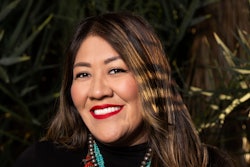PAWNEE, Okla.
Working full-time with a family to support, Cedric Sunray said he didn’t have much time to work on a college degree. Still, the desire was there, and Sunray, 31, said he rushed to be one of the 90 people enrolled in the Pawnee Nation College when it started classes last fall.
“I wouldn’t do it anywhere else,” Sunray said. “Tribal colleges offer classes that are historically not offered anywhere and tribal colleges depend on workforce students.”
Flexing sovereignty and economic clout spurred in some cases by Indian gambling, tribal colleges are growing around the country. Nationally, there were no tribal colleges before 1968. Today, there are more than three dozen in the U.S. and one in Canada. Oklahoma, which didn’t have a tribal college until 2002, now has four seeking accreditation and financing.
“It’s been a slow process, but we are happy to be where we are,” said Gerald Gipp, executive director of the American Indian Higher Education Consortium. “We’re going through a real learning process of operating our schools and reversing decades of neglect.”
Tribal colleges developed along with a growth in American Indians seeking higher education. American Indian enrollment in universities more than doubled during the past 25 years, according to the National Center for Education Statistics.
Simultaneously, enrollment in tribal colleges increased 62 percent in the past decade, according to the higher education consortium. Todd Fuller, president of Pawnee Nation College, said those numbers should continue to grow. He said he expected enrollment at his college to grow at least 40 percent this fall.
“With tribal colleges there is that inherent mission of cultural and language preservation,” Fuller said. “There also has to be a degree path.”
Tribal colleges also may be the last chance to save some native languages, said Quinton Roman Nose. Roman Nose, education director of the Cheyenne-Arapaho Tribes of Oklahoma, is helping develop a tribal college on the campus of Southwestern Oklahoma State University in Weatherford.
“Some tribes have their own syllabary. Others have languages that aren’t written. This is a really complicated area to try and preserve and teach a language,” Roman Nose said. “There’s a great need and this is one way of meeting it.”
Course offerings reflect tribal goals. In Oklahoma, the Muscogee (Creek) Nation offers Creek language as a means to preserve the tongue. The tribe also made it mandatory for Creek Headstart teachers to teach the language.
In South Dakota, Sinte Gleska University’s Lakota Studies Department has been integrating Lakota traditional values and history into academics since 1973. Nebraska Indian Community College, among other programs, offers an associate’s degree in tribal business management. In Wyoming, Wind River Tribal College offers an Arapaho language class accredited through Southwestern Oklahoma.
Tribal colleges also offer a challenge that may be unique in an American Indian student’s life, Sunray said.
“There are no excuses at a tribal college,” Sunray said. “You can’t look at a teacher and say he doesn’t like me because of so-and-so.”
Instead of having a white instructor, students likely will see another tribal member teaching, he said. They’re not there to get rich, but to make a difference, Sunray said.
“They are going to make you work,” he said.
The institutions, however, face an uncertain future. Characterized by rural isolation, limited property tax base, and benign neglect from state governments, growth of tribal colleges has been uneven. At least seven have failed in the past 25 years, but another 17 new institutions have opened.
They keep appearing because there is a need, said Roman Nose, whose great-grandfather, Henry, attended Carlisle Indian School in Pennsylvania.
“Even our own tribal members ask ‘Why do we need to do this?’” Roman Nose said. “We have needs that can’t be met any other way.”
Funding remains key for any startup, the Pawnee’s Fuller said. As president, he has worked to fund a new university and refurbish buildings for classroom space. The Cheyenne-Arapaho could only consider a tribal college after establishing a gambling operation, Roman Nose said.
“With more economic power, with more wealth, we are able to do this,” Roman Nose said.
In North Dakota, United Tribes Technical College in Bismarck has had to fight for funding after it was eliminated from President Bush’s budget proposal for the fifth straight year. Earlier this year, the state’s congressional delegation said Congress restored $3.5 million.
Gambling has aided some tribes, Gipp said, but not all. Most tribal gambling centers are in remote areas, and tribes have many needs to cover, he said.
“These are schools chartered by the tribe,” Gipp said. “So, it does indicate that tribes are feeling confident in where they are going.”
In Pawnee, Sunray said most of his classmates are seeking an education as a means to improve their lives. He hopes, however, that a tribal college education will do more for his 5-year-old daughter and his 1-year-old son, he said.
“They’re more apt to treat people better if they know who they are, if they’re not marginalized,” Sunray said. “They’ll get along better with others and feel strong in who they are.”
— Associated Press
| Reader comments on this story: |
| There are currently no comments on this story. |
© Copyright 2005 by DiverseEducation.com















